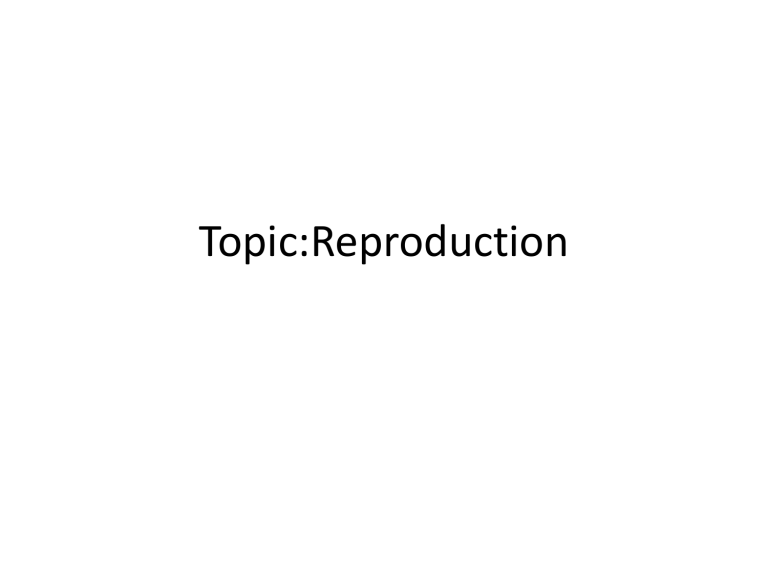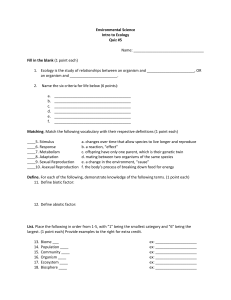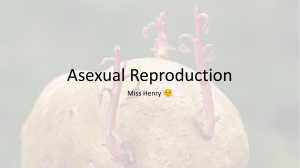Asexual Reproduction Methods
advertisement

Topic:Reproduction • Reproduction is the process by which offspring are produced to continue the species. Reproduction Asexual Reproduction Sexual Reproduction A. Asexual Reproduction • - Is the production of identical offspring from a single parent by simple division without fertilization • - There are no variations. Asexual Reproduction Natural Artificial Binary Fission Cutting Budding Cloning Sporulation Tissue culture Vegetative Propagation Regeneration A - Natural asexual reproduction • 1) Binary Fission: a parent cell is divided into two identical, equal cells • Seen in bacteria, blue green algae and most protista • 2) Budding: The cell or cells divides mitotically forming a bud on the certain parts of an organism • seen in Yeasts, sponges, coelenterates and some non-flowering plants • 3) Sporulation: • - Spores are haploid reproductive cells are produced by some organisms • - In favourable conditions they grows into new organism • - Spore formation is seen in some fungi, algae and protozoa • - Some bacteria produce an endospores that covered a thick protective layer when environmental conditions become unfavourable • 4) Vegetative Propagation • - Root, stem and leaves are called vegetative organs in plants. • - In vegetative propagation they give rise to new plants • 4a) Stem Tuber: Tuber is a stem extension that can store starch in underground. ex: potato • if you plant a tuber, each bud on the tuber will develops into new plant • 4b) Stolons and Runners: are horizontal stems that extend over surface of the soil. Ex: strawberry • 4c) Rhizomes: Are thick horizontal root-like underground stems. Ex: bananas, ferns, irises • 5) Regeneration: is the producing a new organism from broken or damaged part of a parent organism • Ex: Planaria, earthworms, sea stars B - Artificial Asexual Reproduction • - used in agriculture and biotechnology • 1. Cutting: A root or shoot (has no secondary growth) of a plant are use to form a new plant by cutting • Firstly the roots must develop before it planted to soil Formation of roots in water 2. Bud and Stem Grafting • Artificial joining of the stem or bud of one plant to another stem of plant Stem grafting Bud grafting • Advantages of Vegetative and Artificial Propagation • - Genetic continuity of some genetic traits as its parents • - Plants can be produced rapidly according to seed formation Tissue culture • Tissue culture is the producing of a new organism from a small amount of the parent tissue. • - Placing a part of tissue in a special medium that contain many growth hormones, nutrients and O2, can produce new shoots, roots and leaves • - By culturing some animal and human tissues can be produced, and these tissues can be replaced with unhealthy tissues in the body CLONING • We will learn when we learn Animal Reproduction





